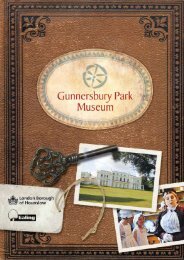Hanworth Park Management Plan - Hounslow.info
Hanworth Park Management Plan - Hounslow.info
Hanworth Park Management Plan - Hounslow.info
You also want an ePaper? Increase the reach of your titles
YUMPU automatically turns print PDFs into web optimized ePapers that Google loves.
Appendix 4 - Conservation at <strong>Hanworth</strong> <strong>Park</strong><br />
London Borough of <strong>Hounslow</strong><br />
Much of the grassland within <strong>Hanworth</strong> <strong>Park</strong> is surprisingly diverse, and shows<br />
characters of acid grassland. Sweet vernal-grass (Anthoxanthum odoratum) and red<br />
fescue (Festuca rubra) are abundant in the sward, and pignut (Conopodium majus),<br />
an uncommon plant associated with acid grassland, is frequent, along with<br />
commoner wild flowers. The grassland holds wintering skylarks and meadow pipits,<br />
and a good range of invertebrates, including a good population of the small heath<br />
butterfly, and the conspicuous wasp spider (Argiope bruennichi). A bee bank has<br />
been established in the southwestern corner of the site for mining bees and wasps.<br />
A small area of wet woodland on the eastern edge of the park is dominated by<br />
various willows (Salix spp.), with a ground flora including false fox-sedge (Carex<br />
otrubae), pendulous sedge (C. pendula) and yellow iris (Iris pseudacorus). This area is<br />
important for invertebrates and amphibians, and grass snakes have been recorded.<br />
Large numbers of soprano pipistrelle bats forage around the edges of the woodland<br />
surrounding <strong>Hanworth</strong> House.<br />
The Longford River runs through the park, though it is in a culvert for part of this, and<br />
continues for about a kilometre east to the borough boundary. The channel contains<br />
unbranched bur-reed (Sparganium emersum), while a few plants of water dock<br />
(Rumex hydrolapathum) and other marginals cling to the steep banks. Sandwiched<br />
between Feltham Marshalling Yards and <strong>Hanworth</strong> <strong>Park</strong>, De Brome Playing Fields is a<br />
mixture of acid grassland, neutral grassland and scrub. In winter the site is used by<br />
skylark and meadow pipit and the site holds many of the invertebrates present on<br />
<strong>Hanworth</strong> <strong>Park</strong> including good populations of the small heath butterfly.<br />
The grassland of <strong>Hanworth</strong> <strong>Park</strong> supports a rich and diverse wildlife and is by far the<br />
largest continuous area of lowland dry acid grassland in the Borough. The park is<br />
designated as a Site of Local Nature Conservation of Borough Importance (Grade II),<br />
together with the Longford River that flows through and beneath the site.<br />
A large proportion of the park (approx. 50ha) has potential as a site for lowland dry<br />
acid grassland regeneration. Around <strong>Hanworth</strong> House, 12.5 hectares of the site is<br />
currently actively managed as acid grassland meadow.<br />
Lowland dry acid grassland is a declining habitat with less than 30,000 hectares now<br />
present in Britain. It develops on nutrient poor, acidic sands and gravel. In London, it<br />
is confined to a few remnants of the once large commons and heaths that dominated<br />
the Thames Terrace gravels. Dry acid grassland habitats support fine-leaved grass<br />
species such as fescues, which plays host to many invertebrates, in particular, bees,<br />
wasps and ants that occur only in these habitats and are rare both locally and<br />
nationally.<br />
Wildlife that can be enjoyed or seen in the park includes birds such as skylarks,<br />
kestrels, and meadow pipit, as well as small heath, small copper and meadow brown<br />
butterflies.<br />
In the Northern part of the site, there is, complete with an interpretation panel, a<br />
habitat which supports a variety of bees.<br />
Page A21



